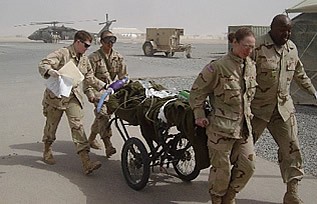© Constance J. Moore
Colonel, ANC (Retired), ANCA Historian
Army nurses who deployed to Iraq and Afghanistan hold the distinction of serving in the longest war in the history of our nation. To ensure the highest level of healthcare for their patients, they practiced nursing with a “twist.” This means “nurses need not only top-notch nursing knowledge and skills, but also an ability to adapt to circumstances and environment.”1

CPT Tara Spears (at left) escorts a patient into the 86th Combat Support Hospital in Iraq.
|
To begin with, the deployment to dangerous situations behooved nurses to be competent with their soldier skills. “Every soldier ... [was] armed properly, and equipped with a strong foundation and knowledge of soldiering skills.”2 Relearning about protective gear, map reading and new subjects, such as convoy protection and media relations, were important confidence-building instruction. Carrying a loaded weapon, and ammunition at all times of the day became second nature. After a while, many nurses felt funny if they don’t have the extra weight with them in the shower. They constantly checked their body armor for a secure fit. When there wasn’t any noise such as mortar fire, it seemed wrong.3
The environment was stressful not only because of the danger but also because of the heat—as high as 140° F.— and the dust. Equipment broke down, generator overheated, and supplies were “crispy and brittle. [Some] gloves turned to powder in your hand.”4 Creativity, the hallmark of Army nursing, was required to find or fix the equipment and find new supplies or fix something else to do the job.

CPT Spears sutures a soldier’s finger. |
Army nurses communicated through interpreters and needed to be “culturally aware and sensitive to issues surrounding modesty.”
5 Basic assessment skills from nursing school were dusted off and used. When verbal communication failed with non-English speaking individuals, initial assessments relied on simple observations of facial grimaces for pain, hot foreheads for fever, or fearful eyes for pain and stress. Pointing to areas of concern also helped.
The type of injuries that Army nurses cared for were everything from the common cold to double amputees. Sometimes the common cold was really something else, like a significantly sleep-deprived individual. “Three hots and cot” were what they required.
Caring for patients with multiple traumatic injuries meant several surgical interventions and many pieces of equipment post–op. Nurses who cared for the victims of insurgent-made bombs remarked they expected to see double or triple limb amputations with other horrible injuries.
Nurses trained in trauma and burn principles had the right skill sets for this patient population.7 “The level of injuries and intensity of the daily pace required a stamina and mental preparation not expected at the time of deployment.”8
How did they cope? Many wrote journals about their experiences; several found or relied on their spiritual beliefs; others worked out at the gym; and several took on-line courses to further their education. Often on their time off, nurses would come back to their units to help train new staff. All felt changed by their experiences.9
Army nursing with a twist meant capable, resilient healthcare workers did what they were asked to do and more. No matter, where or when, they are called upon, Army nurses have focused on their primary objective—to give the best care possible care to their patients.
1 Laura Favand, and Belinda Spencer, “Nursing Care on the Battlefield,” American Nurse Today, accessed November 22, 2015, http://www.americannursetoday.com/nursing-care-on-the-battlefield/
2 Ibid.
3 Ibid.
4 Janet Agazio, “Army Nursing Practice Challenges in Humanitarian and Wartime Missions,” International Journal of Nursing Practice 16, no. 2, (April 2010), 171-172.
5 Ibid., 169.
6 Dusty Filiung, and Lisa Bower, “Medical-Surgical Nursing at the 86th Combat Support Hospital (2007-2009) in Support of Operation Iraqi freedom: Caring for Host Nation Patients, Military Medicine 175, no. 5 (May 2010), 304.
7 Ibid.
8 Janet Agazio, “Army Nursing Practice Challenges,” 173.
9 Ibid.